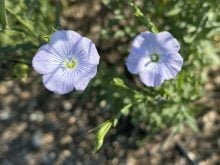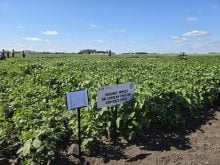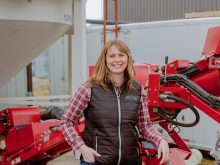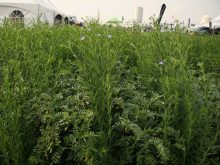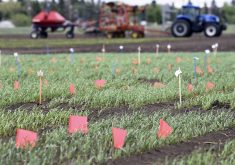Researchers who want to optimize flax for seed production must backtrack on 8,000 years of agricultural development
SASKATOON — When Bunyamin Tar’an introduced a new flax variety, CDC Esme, to an audience of farmers, the question from the floor was immediate: what about the straw?
“Similar to (CDC) Glas,” he said.
“Almost all the plants have similar structure. A lot of the challenge with flax is that the straw is really, really hard to chop.”
Tar’an, a flax and chickpea breeder and professor with the University of Saskatchewan’s Crop Development Centre, was speaking at the Crop Production Show in Saskatoon Jan. 9, where he gave a summary of new CDC varieties in a number of different crop types.
Read Also

Huge Black Sea flax crop to provide stiff competition
Russia and Kazakhstan harvested huge flax crops and will be providing stiff competition in China and the EU.
Tar’an said a main challenge in developing new flax varieties is the lack of genetic diversity. Flax has been cultivated for at least 8,000 years, probably beginning in the cradle of human agriculture, the Fertile Crescent, in what is now the Middle East.
Those early farmers and the generations after them grew flax not for its seed but its tough, durable fibre, valued for its use in fine fabrics such as linen and a wide range of other products such as rope, twine and paper.
“You have to remember flax was initially domesticated not for seed or grain; it was for fibre,” Tar’an said.
“You see a mummy from 9,000 years ago; it was covered in flax linen.”
For millennia, farmers selected the tallest, straightest plants with the fewest branches. Fibre flax varieties can grow to 1.2 metres tall, compared to 40 to 90 cm for seed varieties typical in Saskatchewan.
“This is why we have this remnant fibre quality no matter what because it was selected for that,” Tar’an said.
Unfortunately for seed flax growers, fewer branches mean fewer flowers and hence less seed. Also, though breeders have been able to create shorter varieties with less straw, they’ve been unable change the quality of that straw.
To get around this problem, Tar’an is going back to the source: a progenitor or ancestral wild flax. It is a wild plant known as pale flax or narrow leaf flax, which grows in the Mediterranean region and is found as far north as Ireland.
“In the future, I’d like to have flax going back to the original, what fibre flax was selected from, which was Linum bielle. I want to bring the diversity back into the gene pool of seed flax.”
Hopefully, within that diversity will be genes that could eventually give farmers flax varieties whose straw doesn’t cause such headaches at harvest time and with residue management. Tar’an would also like to see bushier flax varieties with more flower-bearing and hence yield-boosting branches.
While Tar’an can use modern plant breeding genomic tools such as marker-assisted breeding to knock years off development time, he said these are still long-term goals, probably five to 10 years away.
Tar’an’s flax work was among the 57 crop-related projects included in a $14.7 million announcement made by the Saskatchewan government Jan. 10.
The flax project will receive $317,000 from the province’s Agriculture Development Fund. It is also supported by the Saskatchewan Flax Development Commission, Manitoba Crop Alliance and the Western Grains Research Foundation.






